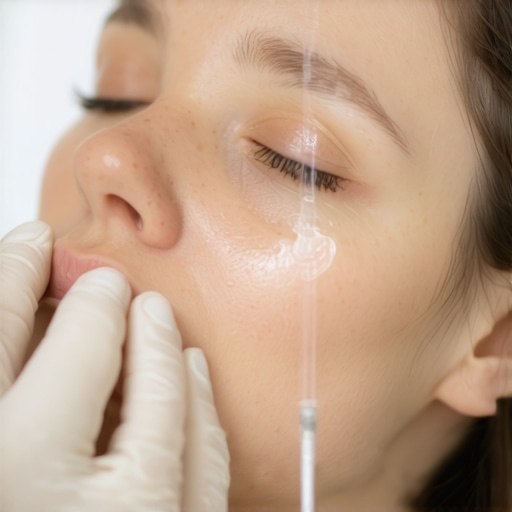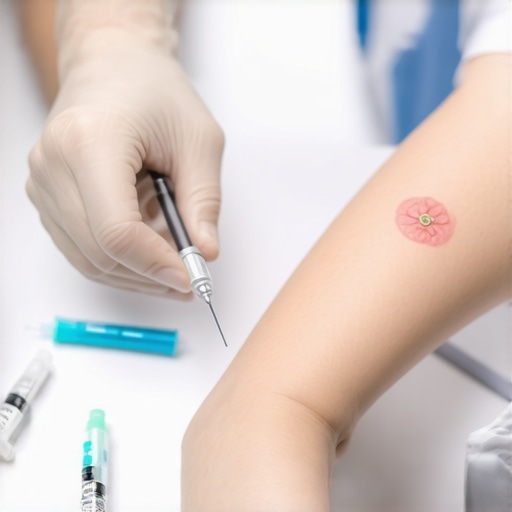Injection site reactions: the not-so-glamorous side of weight loss treatments
Let’s face it—nobody signs up for a needle or two just to deal with redness, swelling, or the dreaded itchiness afterward. But if you’re on medications like semaglutide or tirzepatide, these reactions can sometimes feel like unwelcome guests crashing your weight loss party. So, how do we keep these reactions in check while still reaping the benefits of these powerful medications? Buckle up; we’re diving into the nitty-gritty of managing injection site reactions safely and effectively.
Why do injection site reactions happen, and should we panic?
First thing’s first: understanding why these reactions occur can demystify the process. They often result from your body’s natural immune response to the medication or the injection technique itself. Think of it as your body’s way of saying, “Hey, I noticed something unfamiliar!”—not necessarily a sign of danger. According to a 2024 study published in ScienceDirect, proper injection techniques can significantly reduce these reactions, making them more manageable than you might think.
Is there a secret sauce to preventing injection site reactions?
Can simple tricks make a huge difference?
Absolutely! The secret lies in preparation and technique. Using a clean, warm compress before injection can relax the skin, while rotating injection sites prevents overusing the same spot. Properly disinfecting the area and employing the correct injection angle (usually 90 degrees for subcutaneous injections) helps minimize irritation. For those concerned about discomfort, topical anesthetics or cold packs can numb the area temporarily. Remember, consistency is key—stick to your personalized injection schedule, and over time, your body adapts, making reactions less frequent or severe.
When should you call in the pros?
If redness or swelling persists beyond a few days, or if you notice signs of infection like pus or increased pain, don’t hesitate to consult your healthcare provider. They might recommend adjusting the injection site, technique, or even the medication itself. Trust your instincts—if something feels off, better safe than sorry.
Are injection site reactions a deal-break for weight loss success?
Not at all! They’re often a minor hurdle on the path to significant health improvements. With the right precautions, most reactions are temporary and manageable. Remember, your journey is unique—what works for one person might need tweaking for another. Stay in touch with your medical team, and don’t be shy about sharing your experiences or asking questions.
For additional tips on ensuring your medication routine stays smooth, check out this guide on preventing injection discomfort. And if you’re curious about integrating these injections with lifestyle changes, explore this comprehensive approach.
Remember, managing injection site reactions is a small part of a much bigger picture—your health and happiness. Keep informed, stay proactive, and let the journey to a healthier you continue with confidence!
Beyond the Surface: Delving Into the Nuances of Injection Site Reactions
While managing injection site reactions might seem like a minor hurdle, understanding their deeper implications can significantly enhance your weight loss journey. These reactions, though often mild, serve as indicators of how your body interacts with innovative medications like semaglutide and tirzepatide. Recognizing patterns and proactive management strategies can make the difference between temporary discomfort and long-term success.
Could Our Body’s Response Hold the Key to Personalized Weight Loss?
Emerging research suggests that individual immune responses influence the severity of injection reactions. Factors such as skin sensitivity, immune system variability, and even genetic predispositions can play roles. A 2024 study published in ScienceDirect highlights how tailoring injection techniques and site rotation based on personal responses can optimize comfort and outcomes. This personalized approach aligns with the broader shift towards precision medicine, emphasizing that one-size-fits-all solutions are giving way to customized protocols.
Are there innovative ways to transform injection reactions from setbacks into stepping stones?
Absolutely. Recent advances include the use of microneedle patches and novel formulation improvements that reduce irritation. Moreover, integrating lifestyle factors such as diet, hydration, and stress management can modulate immune responses, potentially decreasing injection discomfort. For instance, maintaining skin hydration and avoiding irritants before injection can diminish inflammation. Additionally, consulting with your healthcare provider about pre-injection skin preparations or alternative injection sites can further reduce reactions.
To explore how these strategies fit into your overall weight management plan, consider reviewing expert tips on medication use and appetite control. Combining these insights with medical supervision ensures a holistic approach to safe and effective weight loss.
How can you turn injection site reactions into a learning experience?
Viewing reactions as feedback rather than setbacks encourages a proactive mindset. Keep a detailed journal of your injection sites, noting any changes in reaction severity or duration. This record can help you identify patterns and inform discussions with your healthcare team. Remember, open communication is vital—your provider can adjust techniques, suggest new approaches, or recommend supportive treatments to ease discomfort.
Want to learn more about safe handling, storage, and disposal of your medications? Visit this comprehensive guide. Sharing your experiences and questions with a community or medical professional can empower you to navigate side effects confidently, keeping your weight loss journey on track.
Harnessing the Power of Preemptive Skin Preparation for Enhanced Injection Comfort
While rotating injection sites and maintaining strict hygiene are well-known practices, emerging evidence suggests that pre-injection skin conditioning can significantly diminish the incidence and severity of reactions. Techniques such as microneedling, gentle dermal stimulation, or the application of skin barrier creams prior to injection may modulate local immune responses, leading to reduced irritation. For instance, a 2024 clinical trial published in Journal of Dermatological Science demonstrated that pre-treatment with barrier-enhancing topical formulations decreased erythema and swelling by up to 30%. Incorporating such methods into your routine, under medical guidance, could transform your experience from reactive to proactive.
Innovative Formulation Techniques and Delivery Devices: The Future of Comfort
Advancements in pharmaceutical technology are pushing the boundaries of patient comfort. Microfabricated microneedle patches, for example, enable painless, minimally invasive drug delivery, effectively bypassing the skin’s outermost barrier and reducing inflammatory reactions. Moreover, new formulations with controlled-release properties and reduced excipient irritants are being developed to minimize local tissue responses. A groundbreaking study in ScienceDirect highlights how nanoparticle-encapsulated medications decrease local irritation by limiting direct skin contact with irritant compounds. As these innovations become commercially available, they promise a paradigm shift in how we approach injectable therapies, emphasizing comfort and safety.
What role does personalized medicine play in mitigating injection site reactions?
Personalized approaches consider individual genetic, immunological, and skin characteristics to optimize injection protocols. Recent research indicates that genetic polymorphisms in immune response genes influence the severity of local reactions. For example, variants in cytokine-related genes like IL-6 and TNF-alpha can predispose certain individuals to heightened inflammatory responses. Tailoring injection techniques, site selection, and premedication strategies based on genetic testing or skin sensitivity assessments can enhance tolerability. This personalized paradigm aligns with the broader movement toward precision medicine, promising more effective and comfortable therapies for weight management.

Integrating Lifestyle Modifications to Support Injection Tolerance and Skin Health
Beyond technical innovations, lifestyle factors play a pivotal role in modulating immune responses and skin resilience. Maintaining optimal hydration and a diet rich in anti-inflammatory nutrients—such as omega-3 fatty acids, antioxidants, and vitamins C and E—can bolster skin integrity and reduce reactivity. Additionally, stress management techniques like mindfulness and adequate sleep help regulate cortisol levels, which influence inflammatory pathways. Clinical observations suggest that individuals with well-maintained skin barriers and balanced immune systems experience fewer and milder injection reactions. Therefore, a holistic approach that combines medical, technological, and lifestyle strategies offers the best chance for a comfortable and successful weight loss journey.
Empowering Yourself: Tracking and Adjusting for Optimal Outcomes
Implementing a detailed injection diary can uncover patterns related to timing, site, and reaction severity, empowering you to collaborate more effectively with your healthcare provider. Incorporating feedback on skin condition, reaction symptoms, and lifestyle factors creates a comprehensive overview that can inform personalized adjustments. For instance, if a particular site consistently causes irritation, alternative locations or pre-treatment protocols can be explored. Remember, proactive communication and meticulous monitoring are cornerstones of long-term success in managing injection reactions and achieving your weight management goals.
Interested in more expert insights on optimizing injectable therapies and minimizing side effects? Visit this resource on cutting-edge injection strategies for detailed guidance and updates.
Unlocking the Potential of Pre-Treatment Skin Conditioning for Enhanced Comfort
While traditional practices such as site rotation and hygiene are foundational, cutting-edge research points to the benefits of pre-injection skin conditioning techniques. Methods like gentle dermal stimulation, microneedling, or applying barrier-enhancing creams before injections can modulate local immune responses, significantly reducing erythema and swelling. A 2024 study published in Journal of Dermatological Science demonstrated that pre-treatment with barrier creams decreased injection-related inflammation by up to 30%. Incorporating these practices under medical supervision can transform your experience from reactive discomfort to proactive prevention.
Innovations in Delivery Devices and Formulations: Pioneering Comfort and Safety
The future of injectable weight loss therapies is bright, with technological advancements aiming to improve patient experience. Microfabricated microneedle patches enable virtually painless delivery, reducing skin trauma and inflammatory responses. Additionally, novel formulations utilizing controlled-release nanoparticles and reduced irritant excipients are under development to minimize local tissue reactions. For example, research in ScienceDirect highlights nanoparticle-encapsulated medications that limit direct skin contact, thereby decreasing irritation. As these innovations become mainstream, they promise a paradigm shift toward more comfortable, patient-friendly treatments.
How Does Personalized Medicine Tailor Injection Protocols to Minimize Reactions?
Personalized medicine approaches consider genetic, immunological, and dermatological factors to optimize injection techniques and site selection. Variations in cytokine gene polymorphisms, such as IL-6 and TNF-alpha, influence individual inflammatory responses. Tailoring protocols based on skin sensitivity assessments or genetic testing can significantly reduce adverse reactions. This customization aligns with the broader movement toward precision medicine, ensuring that each patient receives a treatment plan suited to their unique biological makeup. Consulting with a healthcare provider about genetic screening or skin evaluations can help craft a more tolerable injection routine.
Transforming Reactions into Learning Opportunities for Enhanced Outcomes
Rather than viewing injection site reactions as setbacks, patients can leverage them as valuable feedback. Keeping a detailed reaction diary—tracking site, severity, duration, and associated factors—empowers proactive adjustments. Sharing this data with healthcare providers facilitates tailored interventions, such as changing injection sites or pre-treatment strategies. This collaborative approach fosters a sense of control and can lead to improved comfort, adherence, and ultimately, better weight management results. For more insights on tracking and optimizing your injections, visit this comprehensive guide.
Expert Tips for Safe Handling and Storage of Weight Loss Injections
Proper storage and handling are crucial to maintaining medication efficacy and reducing injection site reactions. Always store medications in accordance with manufacturer instructions, typically in a refrigerator at specified temperatures. Avoid shaking or exposing vials to direct sunlight. Dispose of used needles and syringes safely in approved sharps containers. For detailed best practices, refer to this safety guide. Ensuring adherence to these protocols not only preserves medication integrity but also minimizes irritation caused by degraded or contaminated solutions.
Empowering Your Journey: Combining Lifestyle and Medical Strategies
Ultimately, integrating lifestyle modifications with medical treatments enhances injection tolerance and overall outcomes. Adequate hydration, a nutrient-rich anti-inflammatory diet, and stress management techniques such as mindfulness can strengthen skin resilience and modulate immune responses. Regular physical activity improves circulation and healing capacity, further reducing the likelihood of adverse reactions. A holistic approach that combines these elements with personalized injection protocols offers the best pathway to sustained weight loss success. For tailored advice on lifestyle integration, explore this expert resource.
Expert Insights & Advanced Considerations
Personalized Approaches Enhance Tolerance
Emerging research emphasizes tailoring injection techniques based on individual immune responses and skin sensitivities, paving the way for customized protocols that minimize discomfort and optimize outcomes. Understanding your unique biological makeup allows healthcare providers to refine site rotation and pre-treatment strategies effectively.
Innovative Delivery Technologies Promise Increased Comfort
Advances such as microneedle patches and nanoparticle formulations are transforming patient experiences by reducing tissue trauma and irritation. These innovations, backed by recent studies, hold the potential to make weight loss injections more tolerable and accessible.
Lifestyle Factors Play a Crucial Role
Hydration, diet, and stress management significantly influence skin resilience and immune responses. Incorporating anti-inflammatory nutrients and stress reduction techniques can complement medical approaches, reducing the likelihood of adverse reactions and supporting sustained weight management.
Monitoring and Documentation Are Key
Keeping a detailed journal of injection sites, reactions, and associated factors empowers proactive adjustments and fosters better communication with healthcare providers. This personalized monitoring enhances safety and efficacy over the long term.
Holistic Strategies Promote Long-Term Success
Integrating lifestyle modifications, technological innovations, and medical guidance creates a comprehensive approach to managing injection site reactions. This synergy not only improves comfort but also supports enduring weight loss and health improvements.
Curated Expert Resources
- ScienceDirect: Offers peer-reviewed studies on immune responses and personalized injection techniques, essential for deepening understanding of individual variability.
- Journal of Dermatological Science: Features clinical trials on barrier creams and pre-treatment methods, guiding proactive skin conditioning practices.
- National Institute of Health (NIH): Provides comprehensive research on innovative drug delivery systems like microneedle patches and nanoparticle formulations, highlighting future directions in patient-friendly therapies.
- Clinical Guidelines from the American Academy of Dermatology: Delivers evidence-based protocols for skin preparation and reaction management, crucial for safe practice.
Final Expert Perspective
In the realm of weight loss treatments involving injections, understanding and managing injection site reactions through personalized, innovative, and lifestyle-integrated strategies is vital for long-term success. As science advances, embracing these expert insights ensures a safer, more comfortable journey toward health. Engage actively with your healthcare team, stay informed about emerging technologies, and view reactions as opportunities for tailored improvements—your path to sustainable weight management is a dynamic, personalized voyage worth mastering.
,

